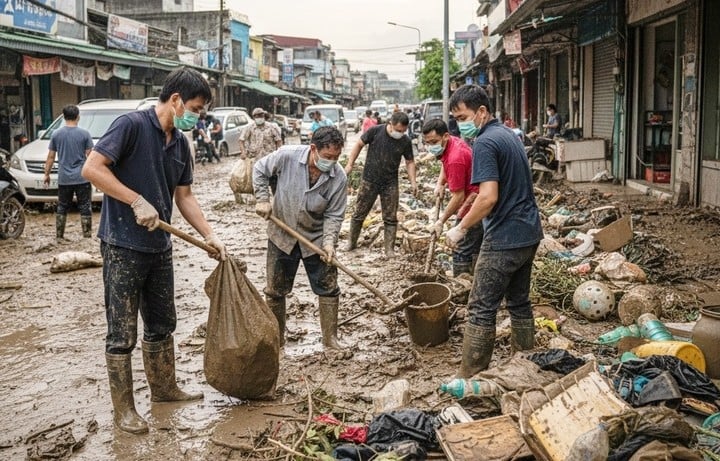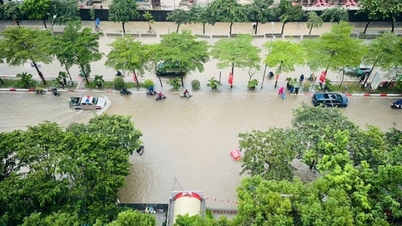After storms and floods, the living environment is often seriously polluted. Floodwater carries garbage, animal carcasses, mud, and clogged drainage systems, creating ideal conditions for bacteria and viruses to grow.
According to Dr. Truong Anh Thu - Head of Infection Control Department, Bach Mai Hospital - diseases that easily break out after natural disasters are mainly transmitted through the respiratory tract, digestive tract and skin and mucous membranes.
“Proactively preventing and controlling infections from the beginning plays a key role in reducing the risk of disease outbreaks after natural disasters,” Dr. Thu emphasized.
Four groups of diseases commonly encountered after storms and floods
Respiratory diseases such as pneumonia, Seasonal flu, COVID-19… have the highest rate, often spreading when people have to evacuate, in cramped, poorly ventilated places.
Digestive diseases such as acute diarrhea, cholera, dysentery, hepatitis A/E... are often caused by eating contaminated food or water.
Skin infections, Tetanus occurs when broken skin comes into contact with flood water or dirty mud without being treated properly.
Diseases transmitted by mosquitoes and rats such as Dengue fever, malaria, leptospirosis (disease caused by Leptospira bacteria from rats)… often increase after the flood, because mosquitoes and rodents thrive in humid environments with lots of waste.
Additionally, food is susceptible to mold if improperly stored in the prolonged power outage and damp conditions following flooding. After just 48 hours, spoiled food can become a potential source of infection.

Infection control measures
Proper hand hygiene: Use soap and clean water if available. If water is not available, use an alcohol-based hand sanitizer. Prioritize hand washing before eating, after using the toilet, or after handling waste.
Water treatment: Drinking water should be boiled for at least 1 minute. If untreated water must be used, odorless chlorine bleach (containing 5.25% sodium hypochlorite) may be diluted at a rate of 1/8 teaspoon per 1 liter of water. Well water should be chlorinated and tested for microbiology after at least 48 hours.
Ensuring food safety: Store food in a cool, dry place. Discard perishable food if left at room temperature for more than 2 hours. People with signs of infectious disease should not prepare food.
Disinfect surfaces and living environments: Prioritize cleaning flooded areas. Use diluted chlorine solution (0.1-0.5%) to clean floors, walls, and household items. Check ventilation systems and treat mold and insects as soon as the water recedes.
Provide personal protective equipment (PPE) for clean-up workers, rescue workers, and residents who clean up after floods. Avoid touching eyes, nose, and mouth with dirty hands. Any wounds should be treated immediately and the need for tetanus vaccination assessed. Dispose of waste properly to avoid spreading pathogens to the environment.
Monitor your health daily, especially for signs such as fever, diarrhea, rash, Skin infection. Promptly notify medical facility if there is any abnormality.
The post-flood period is the time when comprehensive cleaning of houses, schools and hospitals is required. It is necessary to thoroughly clean and disinfect contact surfaces and ensure that the natural ventilation system is working properly.
“ Do not be complacent after the storm has passed. This is when epidemics are likely to occur if infection control is neglected, ” Dr. Thu warned.
Source: https://baolangson.vn/bon-nhom-benh-thuong-gap-sau-bao-lu-5061174.html


![[Photo] Unique Phu Gia horse hat weaving craft](https://vphoto.vietnam.vn/thumb/1200x675/vietnam/resource/IMAGE/2025/10/10/1760084018320_ndo_br_01-jpg.webp)


![[Photo] "Exposing letters" in the flood center of Lang Son](https://vphoto.vietnam.vn/thumb/1200x675/vietnam/resource/IMAGE/2025/10/10/1760080117518_ndo_br_z7101324112737-07cd4d1c01801a8ccf4ae0cbaf31c4a3-507-jpg.webp)
![[Photo] Standing member of the Secretariat Tran Cam Tu works with the Standing Committee of the Party Committee of the Ministry of Health](https://vphoto.vietnam.vn/thumb/1200x675/vietnam/resource/IMAGE/2025/10/10/1760079818773_image-4-6972-jpg.webp)




























































































Comment (0)